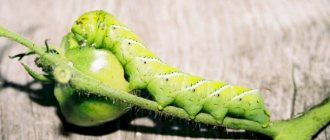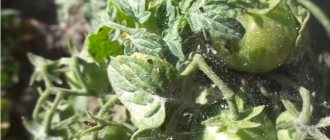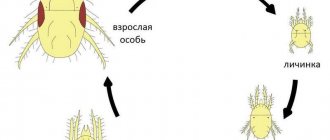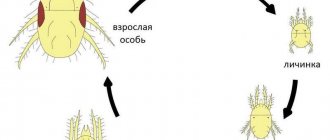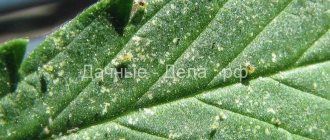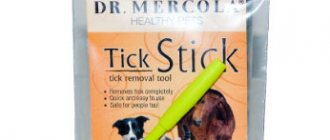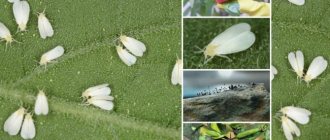Midsummer, hot and dry. These are ideal conditions for the worst pest – spider mites. The spider mite is a polyphagous pest; it affects various cultivated plants, flowers, shrubs, and does not disdain weeds. It can live both in open ground and in a greenhouse. But most of all he loves to live in cucumber beds. If you don’t notice it in time, and it is sometimes quite difficult to notice it due to its microscopic size, then you can completely lose your cucumber harvest.
Spider mites on cucumbers are the most common pest after fungal diseases. Therefore, processing must be carried out necessarily. If you do not carry out the treatment on time, then at least you will lose a significant part of the harvest, or the plants will die altogether.
Signs of spider mite damage to cucumbers
It is quite easy to detect the pest. The insect is located on the underside of the leaf, and this is where its development begins. When there is a large accumulation, small cobwebs are formed, hence the name of the insect. The pest, settling on the leaves, begins to feed on its juice. Cucumber leaves begin to fade, yellow spots appear, and the leaves dry out. These are the first signs of a pest.
Having sucked all the juice from the leaves, the mite moves to the stem, wraps itself around all the stems, the plant stops developing normally, photosynthesis stops, dries out and gradually dies.
Causes
A greenhouse is the most favorable place for spider mites to breed: it’s all about elevated air temperatures and minimal humidity. Predisposing factors for the appearance of the pest are:
- excessively dense planting of cucumbers;
- increased dryness in the greenhouse;
- adding mite-infested manure to the soil;
- leaves and stems not harvested after harvest;
- planting cucumbers in one place for several seasons in a row.
Dense planting of cucumbers can lead to the appearance of spider mites.
With prolonged mite infestation, dehydration occurs, which contributes to the loss of nutrients and a decrease in plant immunity. The result is the addition of a bacterial or fungal infection. Together, the disease and the pest lead to deformation, yellowing and death of the bush.
What to do and how to deal with spider mites
Cucumber plants should be periodically inspected for insects. It is easier to prevent any disease than to treat it later. This also applies to insects.
If, during inspection, several leaves with signs of insects are found, then it is necessary to urgently begin to combat them. At the initial stage, when single leaves are affected, they must be urgently torn off and destroyed. At this stage, you can get by with folk remedies, but sometimes they are not so effective. When using biological drugs, their effect may not be immediately visible. Perhaps the best option would be insecticides - chemical agents for killing insect pests, their eggs and larvae. Some of them are effective against herbivorous mites.
There are many ways to combat spider mites, some of them are more effective, others less. What is right for you is your choice. And I will briefly tell you what you can use in such a situation.
Where does this parasite come from and why is it dangerous for the crop?
Spider mites are a fairly common pest that can often be found on cucumber leaves. Despite its size, the animal can completely destroy a planting, quickly populating a garden bed or greenhouse.
Note! The mite causes the greatest damage in film greenhouses and hotbeds, so in these structures you need to especially carefully inspect the backs of the leaves for the presence of rapidly moving dark spots.
The tick gives preference to greenhouses due to its optimal conditions of elevated temperature, which is about +30°C, and a dry climate. In such conditions, the reproduction process easily starts, and many larvae are born.
In extreme summer heat, the parasite may also choose ground cucumbers. It spends the winter in fallen leaves or in the corners of greenhouses, and with warming it appears on cucumbers. The mite can also be found in manure used for fertilizing and on weeds surrounding seedlings.
The parasite feeds on cell sap, which leads to the breakdown of chlorophyll, which is necessary for the functioning of plants. As a result, damaged cells die, which causes a general weakening of the plant and makes it susceptible to diseases, such as mycoses. After the mite, faded spots and milky cobwebs remain on the leaves.
Methods for treating cucumbers against spider mites
The following biological preparations are used to combat spider mites.
- Actofid - the main advantage of the drug is its high effectiveness against spider mites on cucumbers. It disintegrates quickly and is not addictive, which means it can be used repeatedly. Effective in cool and hot weather. The advantage will be its relatively low price.
- Bitoxibacillin is an insecticidal drug based on the activity of certain types of bacteria. The action of the drug is aimed at the digestive system and the reproductive system of insects. As a result, the fertility of pests and the viability of larvae decreases. The effect of use occurs from the first to the tenth day of use of the drug. After a week, you can notice a massive death of pests.
The only disadvantage of these drugs is their short shelf life, only 2 months at a temperature of +2º (due to microorganisms). Experienced gardeners recommend using both of these products simultaneously, adding to them a set of Brexil-Combi microelements (15 g per bucket of water).
Before processing, ripened cucumbers are collected. Pour water into the spray tank and add all 3 drugs. Treat with the solution from bottom to top (remember that insects are on the underside of the leaf). Processing is carried out in the evening.
- Fitoderm is a biological insecticide, a drug harmless to humans, as it is created on the basis of soil microorganisms. Does not cause addiction to insects. After treatment, you can harvest the crop within 2-3 days. It can be bought in specialized stores. Before use, you must read the instructions for use.
How to properly treat cucumbers with medications
Regardless of what type of treatment you choose, it is recommended to carry it out only in the early morning or evening so that solar activity is minimal. Choose calm weather with moderate humidity.
Chemicals should be used taking into account their effect on beneficial insects. This is especially important during the flowering period: pollinated varieties after treatment may not wait for the bees if a drug that is toxic to them was used. Accordingly, harvest volumes will be greatly reduced.
Biological drugs are harmless to humans. They remain on the fruits for up to three days, after which the vegetables can be removed from the bush and eaten after washing. Chemicals remain on the fruits for a very long time; they can only be collected a few weeks after spraying.
If the product remains and all the plants have already been sprayed, you can treat the greenhouse or spill the soil.
Important! Carefully read the instructions for each product you use, do not violate dosages and use personal protective equipment if necessary.
Folk remedies for fighting spider mites in a greenhouse
When there are only a few affected leaves or for the purpose of prevention, folk remedies can be used. They are cheap and can be purchased at your local pharmacy. The most popular of them:
- 3% hydrogen peroxide . Ratio - 2 tbsp. l. hydrogen peroxide per 1 liter of water. We spray for 3 days in a row at a temperature of 30º, after 10 days we repeat the treatment.
- Ammonia . Add the solution at the rate of 1 tsp. for 5 liters of water, spray the leaves on both sides and the ground around the plant. In addition to killing mites, you will feed the plant with nitrogen.
- Iodine . Proportions – 10 drops of iodine per 10 liters of water + 1 liter of low-fat milk. We spray thoroughly on both sides and the trunk of the plant.
- Laundry soap . If there are very few affected leaves, you can wipe the affected leaves with warm soapy water or spray the plant. The remaining soap solution can be poured onto the garden bed nearby. The solution is prepared at the rate of 50 g of soap shavings per bucket of warm water. We wait until the soap dissolves, then we treat the plant. Laundry soap can be replaced with sulfur-tar soap.
- Vinegar . If cucumber seedlings are affected by spider mites, spray with a vinegar solution, ratio 2 tbsp. l. vinegar essence into a bucket of water. Helps cope with other pests (codling moth, cruciferous flea, aphid).
- Mustard . Dilute 60 g of dry mustard powder in 1 liter of water, leave to infuse in a tightly sealed container for 3 days. Then add another 3 liters of water and spray the affected plants. The insect cannot stand the smell of mustard.
Symptoms of crop damage
From the moment the seedlings are planted, the plants need to be inspected every 3 days. Required - leaves on the back side. Early detection of a tick is a guarantee of success in combating it.
Symptoms:
- First, the cucumber spider mite infects the leaves. The first sign is the appearance of a cobweb – a signal that a pest has infested. Individuals are difficult to see immediately due to their small size and scarcity. If you look closely you can see small dots.
- On the outside of the leaves, first small, then extensive yellowish spots appear.
- The disease spreads, the cucumbers have more and more yellowed foliage, the plant weakens, and becomes covered with a web of cucumber mites.
- The leaves dry out, pests crawl onto the stems and inflorescences, the plants begin to die, fruiting weakens or stops.
- The last stage is the defeat of the entire bush.
Note! They begin to actively fight the pest from the first, or at most second, stage, until the cucumber bush weakens.
How to treat cucumbers in open ground against spider mites
For cucumbers in open ground, treatment must be carried out. You can spray the leaves with Fitoverm solution. Treatment begins when the plant reaches half its height or at the beginning of flowering. Treatment is carried out twice with an interval of 10-15 days.
To administer the solution, 1 ampoule of the product is diluted in 1 liter of water. This dosage (according to the instructions) is intended for treating indoor plants, but it also works for cucumbers in open ground.
The treatment is carried out early in the morning or after sunset, the main condition is that there is no sunlight, otherwise the product will quickly evaporate and there will be no effect from the treatment.
Among the folk remedies, the most effective is spraying with plain water, because the insect does not like moisture. But this will need to be done 5-6 times a day. You can also spray with a solution of laundry soap. 15 g of soap are diluted in 2-3 liters of water and sprayed on the plants. Since the insect breathes through its body, the film of soap will not allow the insect to breathe, and it will die.
Signs of a pest
At all mobile stages of development, mites feed on plant sap. The cobwebs on the cucumbers in the greenhouse and the white spots are manifestations of presence. The leaves of the plant begin to turn yellow and curl due to lack of photosynthesis. The general weakening of the vegetable crop makes it defenseless against infections.
The pest is not picky about food; it settles on cucumber seedlings and adult plants.
Consequences of the life activity of the phytophage:
- the formation of white dots and spots in places where leaves are bitten;
- slowing down the growth of vegetable crops;
- flowing web on the leaves and stems of cucumbers.
Advice. If alarming signs appear, take a closer look at the plant. An overgrown colony of arachnids looks like a general moving mass of hundreds of small individuals. People should not be afraid of unpleasant pests; ticks are safe for them. But the crop, especially on closed ground, is on the verge of destruction.
Prevention
Spider mites are quite difficult to fight, and therefore preventive measures will help prevent the mite from being carried into the greenhouse. What should you pay attention to?
- Check leaves regularly for mites. Insects noticed in time will help to deal with the problem faster.
- When purchasing seedlings, do not immediately bring them into the greenhouse. Give her a little quarantine. Leave it in the room or outside for several days. If the seedlings are infected, then after a few days the mites will make themselves felt.
- Pests on cucumbers do not like strong odors, so between planting cucumbers you can plant marigolds, calendula, garlic, and onions. Or put on the garden bed picked plants that insects cannot tolerate: tansy, celandine, dandelion, yarrow, wormwood.
- Loosen the soil more often, but carefully, since the roots of cucumbers are located on the surface.
- Mites from weeds in the garden can be blown into the greenhouse by the wind, so get rid of the weeds.
- Ventilate the greenhouse.
I wish you good harvests!
What does it look like
A spider mite is a tiny parasite of red, red, brown or milky color, which is almost impossible to see with the naked eye, since its size usually does not exceed 1 mm. Its body has a round shape and is divided into 2 parts: a smaller anterior one and a larger posterior one. The upper part of the tick's body is more convex than the lower.
An adult tick has 4 limbs on each side. On each limb there are sharp hooks, with the help of which it moves along the leaves of plants. The parasite has small bristles on its body. They can be needle-shaped, feathery or leaf-shaped and perform the function of touch.
Spider mite larvae have a greenish body with dark spots on the sides.
The tick develops in five stages: egg, larva, two nymph stages and adult.
Chemical protection products for cucumbers
Such drugs also need to be used strictly according to the instructions, not forgetting that these are poisons. They should be used as a last resort. Cucumbers can be treated with one chemical preparation only once, because the next generation of parasites is already adapted to a specific poison. During the season, 3 generations of spider mites are replaced.
A detailed study of the degree of influence of chemicals on spider mites shows that after the first treatment, half of the insects die. After the second spraying, only 10% of these tiny pests remain alive. That is why the area has to be processed three times with intervals of 4 - 6 days.
Biological remedies
Biologically active drugs are not chemical. The bacteria they contain enter the plants without causing them any harm. At the same time, they are deadly for spider mites and a number of other insects. After these bacteria enter the tick’s body along with the juice, the insect becomes ill and soon dies.
The real result with the use of biological products occurs 12 hours after spraying. Such drugs act for a long time. There are a lot of them, but the principle of operation is the same for all. The most popular among gardeners are the preparations “Bi 58”, “Aktofit”, “Vertimek”, “Akarin”, “Agravertin” and “Kleschevit”.
You should know that spider mite eggs laid underground, as well as the larvae located there, are not exposed to biologically active drugs.
The use of these protective agents for different plants should be carried out differently. So read the instructions carefully and strictly follow their instructions.
What harm do mites cause to cucumbers?
Once inside a greenhouse structure, insects quickly spread across its area, immediately occupying more convenient crops, one of which is cucumbers. Insects feed on the sap of plant cells, due to which the leaves are depleted, begin to dry out and lead the plants to disease and death.
It is also worth noting that the females are very active, and after 3-4 days they will lay eggs, up to 400 eggs each. There can be up to 20 development cycles per year, and the most suitable climate for this is +23+33°C and average humidity in the greenhouse. As you can see, the greenhouse is simply ideal for the life of these pests.
